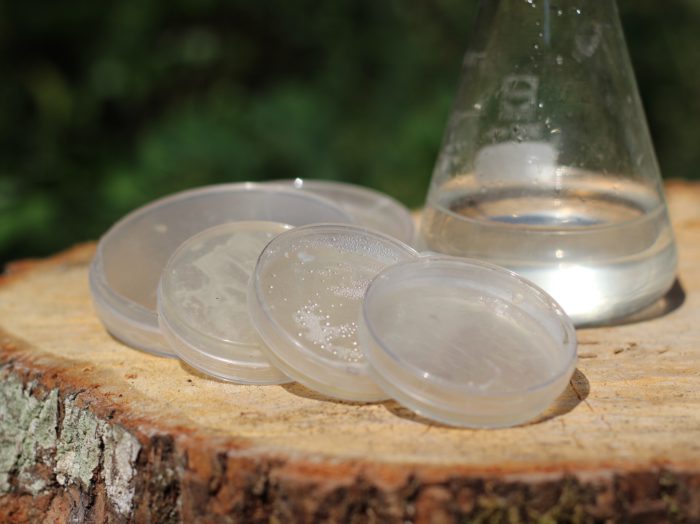Microbes are seen almost as a representation of death, and all that is wrong with nature. People only know rot, mould, and diseases plaguing humanity. However, microbes do decompose, but they also create. Shaking hands is a greeting: a connection that transcends language. By shaping microbial cellulose into a hand, we give ourselves an opportunity to communicate with a form of life that makes up more than we can never imagine. Partnering the microbes with bioluminescent algae, we add to the greeting a personal and humbling response. Humans see themselves as superior and with physical interaction, we change the perspective on what life is.The human eco-system (painting)
We highlight the human microbiome through a self-portrait made using cultures taken from corresponding parts of a human face. This provides us with an insight into how many more micro-organisms live on our bodies, than we can see. In the making of this artwork, we took samples from different parts, such as the skin, the nasal area and around the eyes, and allowed the micro-organisms to grow on the canvas and create what is present.Biospray preservation (interactive installation)
This project uses bacteria grown from the human microbiome, to create a new medium for artists to display they ideas. The bacteria were preserved in a liquid medium and sprayed on nutrient rich agar. They were allowed to grow and then preserved in resin. This project is inspired by spray print, and it is a new form of self-expression and freedom. The art preserves the life and natural growth of the living matter.Bioluminescent checkers (interactive biotic game)
A large boardgame that incorporates bioluminescent bacteria. Both German and American versions of the game can be played on the board. Instructions will be provided for each version in both English and German. This is a cultural project as it blends two cultures in a single boardgame.
Use of bacteria in textile
The textile industry is one of the most polluting industries in the world. 98 million tons of not renewable resources are used every year to produce synthetic fibbers, toxic fertilizers and chemicals to manufacture dies and finish in textile. What if you used the properties of micro-organisms that we have everyday in our environment, to propose a more environmental friendly production of textiles?
Hand sculpture
There are hundreds of microbes inside and outside of our bodies, which we may not notice them. So why don’t make them visible? You may have heard that each person has unique fingerprints, but you have not confronted the unique pattern of living bacteria on your hand. Place your hands on the media and let them grow! We can show you the process at <link>, so do not hesitate and become more familiar with your body.
Microbial handshake
When meeting a new person, the first thing you exchange is a handshake. But that is not the only information transferred. Billions of bacteria live on and in our bodies. And they are easily shared through physical contact. This installation illuminates this normally hidden process, by taking 5 volunteers and sterilizing their hands and creating the optimum canvas for demonstrating this. The first sterile volunteer shakes hands with a non-sterile individual that then shakes hands with the next volunteer. This creates a gradient of bacterial contamination showing on the cultures. Does this process fascinate or frighten you?
Glowing garden (conceptual)
Though many people love culturing flowers, leaves also beautiful patterns of colours. We try to make a plant with glowing veins and let more people know the beauty of leaves. We will use a kind of bacteria to introduce bioluminescence into plants. This process uses genetic modification and some people are not familiar with this technology and suspicious of it. Through this project we will like to show what genetic modification technology is, and how science can create art.

